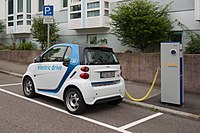Plug-in electric vehicles in Maryland

As of November 2021[update], there were about 41,000 electric vehicles in Maryland.[1]
In 2022, Maryland was ranked by LendingTree as the third-best state in the United States for electric vehicle ownership.[2]
Government policy
[edit]From 2014 to 2017, electric vehicles were eligible to use high-occupancy vehicle lanes in Maryland.[3]
The state government initially[when?] offered a $2,000 tax rebate for electric vehicle purchases; however, this rebate expired in July 2020.[4] In July 2023, the state government will start offering a $3,000 tax credit for electric vehicles, and $2,000 for plug-in hybrid vehicles.[5]
As of August 2021[update], the state government's official policy goal is to have 300,000 electric vehicles in the state by 2025.[6]
As of April 2022[update], the state government is required by law to transition all cars in the state fleet to electric by 2031, and remaining light-duty vehicles by 2036.[7][8]
Charging stations
[edit]As of December 2021[update], there were about 1,000 charging stations in Maryland.[1]
The Infrastructure Investment and Jobs Act, signed into law in November 2021, allocates US$63 million to charging stations in Maryland.[9]
As of April 2022[update], the state government offers tax rebates of $700 for installation of home charging stations.[10]
By region
[edit]Baltimore
[edit]In October 2021, Baltimore County announced plans to replace 10% of its fleet with electric vehicles by 2030.[11]
There have been concerns about racial inequality with regards to the prevalence of charging stations in Baltimore.[12]
Washington metropolitan area
[edit]As of January 2022[update], there were about 13,000 electric vehicles registered in Montgomery County.[4] As of December 2021[update], there were 214 charging stations in Montgomery County.[13]
References
[edit]- ^ a b Argiris, Alex; Touma, Michael (December 9, 2021). "In move to electric vehicles, Maryland is doing better than most". Capital News Service. Retrieved March 26, 2022.
- ^ "Maryland is 3rd among best states to own electric vehicle". The Avenue News. April 28, 2022. Retrieved April 29, 2022.
- ^ "Plug-In Electric Vehicle (PEV) High Occupancy Vehicle (HOV) Lane Exemption". Alternative Fuels Data Center, U.S. DoE. June 4, 2014. Retrieved April 19, 2016.
This incentive is in effect until September 30, 2017.
- ^ a b Walkinshaw, James R. (January 21, 2022). "Opinion: Public charging stations are not the primary impediment to electric cars in Virginia". The Washington Post. Retrieved April 9, 2022.
- ^ "Maryland Reestablishes Electric Vehicle Excise Tax Credits". LAW360. April 22, 2022. Retrieved April 28, 2022.
- ^ Sporer, Alyssa (August 19, 2021). "Will Maryland's expanded EV charging network fuel fleet adoption?". FreightWaves. Retrieved April 9, 2022.
- ^ St. John, Jeff (April 12, 2022). "Maryland just passed one of the most aggressive climate laws in the US". Canary Media. Retrieved April 18, 2022.
- ^ McCarthy, Elizabeth (April 21, 2022). "Maryland takes the lead on near-term state carbon reduction targets". Utility Dive. Retrieved April 23, 2022.
- ^ "In Maryland, Harris unveils plan for electric vehicle charging network". The Daily Record. December 13, 2021. Retrieved April 9, 2022.
- ^ McParland, Tom (April 14, 2022). "I'm Looking For An Electric Replacement To My Twelve-Year-Old Car! What Should I Buy?". Jalopnik. Retrieved April 18, 2022.
- ^ Dieterle, Marcus (October 21, 2021). "Baltimore County to replace government vehicles with electric and hybrid models". Baltimore Fishbowl. Retrieved April 9, 2022.
- ^ Muller, Joann (August 6, 2021). "Biden wants 500,000 EV charging stations. Here's where they should go". Axios. Retrieved April 18, 2022.
- ^ Trompeter, Brian (December 22, 2021). "Fairfax leaders aim to expand infrastructure for electric vehicles". WTOP. Archived from the original on December 22, 2021. Retrieved April 28, 2022.


